
Artist Jaehee Jung, who majored in sculpture in college, explores the possibilities of non-physical video works such as animations and performance videos that physically expand in real space. In Maumbulle (2006), a digital animation of a flying “Maumbulle” with butterfly wings and mosquito’s proboscis is juxtaposed against footage of the corner of an actual empty space. Jung calls it the “fragment of image” that shows an interaction with Momm (2007) and Momm 2 (2007).
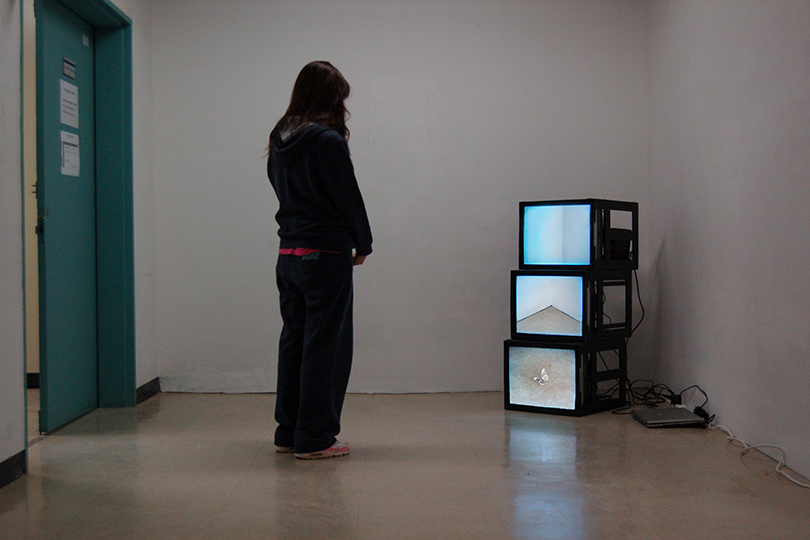
Maumbulle, Monitors, DivX Players, Speakers, Dimensions Variable, 2006. Image courtesy of the artist.
While studying overseas in Braunschweig, Germany, Jung started creating works that utilized electronics as their subject matter. The Technical University of Braunschweig is known as the first technical university in Germany, founded in 1745. On weekends, Jung would go to electronics stores and observe German household appliances such as those made by Braun. Radio Tower (2012) is a towering stack of 10 Phillips radios inside their boxes. Hidden away, the radios create their respective sounds in response to an irregular rhythm. In Yellow Movements (2013), nine small massagers in unopened boxes are placed on the floor, where they vibrate and move around irregularly. In Brush, Shave and Dry (2012), an electric shaver, hair dryer, and Oral-B electric toothbrush (all made by Braun) are placed on white pedestals in their respective boxes. These electronic devices, all of which are used in the morning, vibrate to their own rhythm.
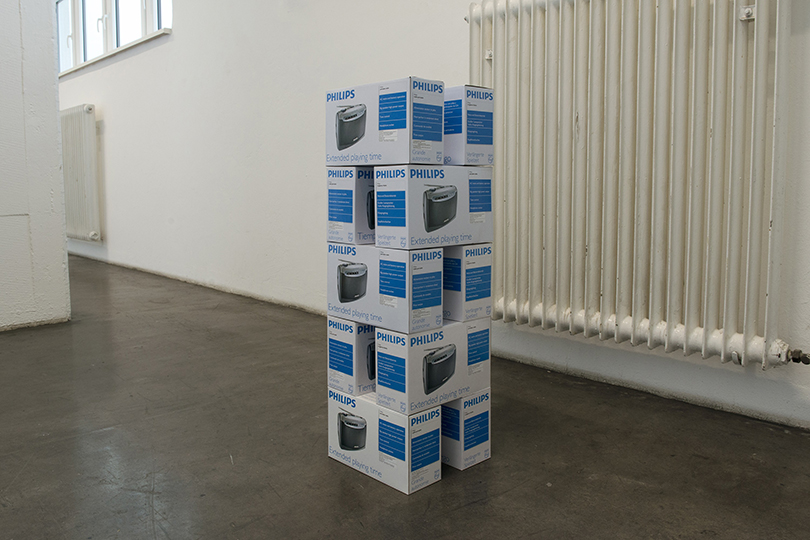
Radio Tower, Radios in Their Boxes, 85 x 27 x 27 cm, 2012. Image courtesy of the artist.
Jung arranges and displays commercial products, usually electronic devices inside their packaging, as if they have found their way into the exhibition space by chance. While deliberately discarding the classical methods and grammar of sculpture, he presents boxes, the cubical shape of which is inevitably cliché, and the product designs covering their surfaces. In Jeff Koons’ famous work New Hoover Convertibles Green, Blue, New Hoover Convertibles Green, Blue Doubledecker (1981–87), four vacuum cleaners inside a plexiglass box shine, boasting their form as products and allowing spectators to closely observe the aesthetics of the forms of everyday home appliances. However, the boxes that contain the electronic goods in Jung’s works deny viewers even the visual formativeness of the shape of the products.
Jung’s act of presenting the boxes of self-operating electronic goods can come across as a joke. A joke usually has an object, and in Jung’s work, this object can be the tradition of sculptural work, the products trembling inside the boxes, or the spectators who cannot function in everyday life without such electronic goods. To the museum-going middle class, his work presents a new context in which they come to revisit products that they have bought and use every day to maintain a comfortable life.
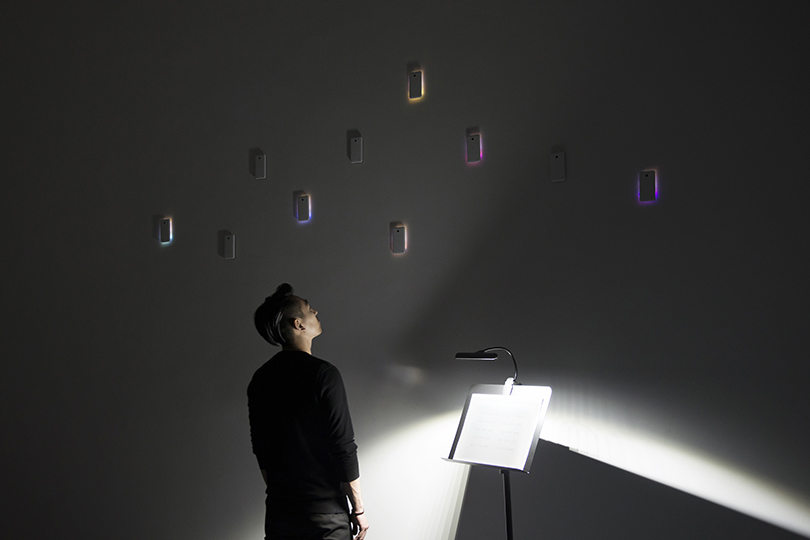
Unsmart Phone Orchestra, Smartphones, Sheet Music Written as Numbers, Music Stand, Music Stand Light, 280 x 280 x 100 cm, 2016. Image courtesy of the artist.
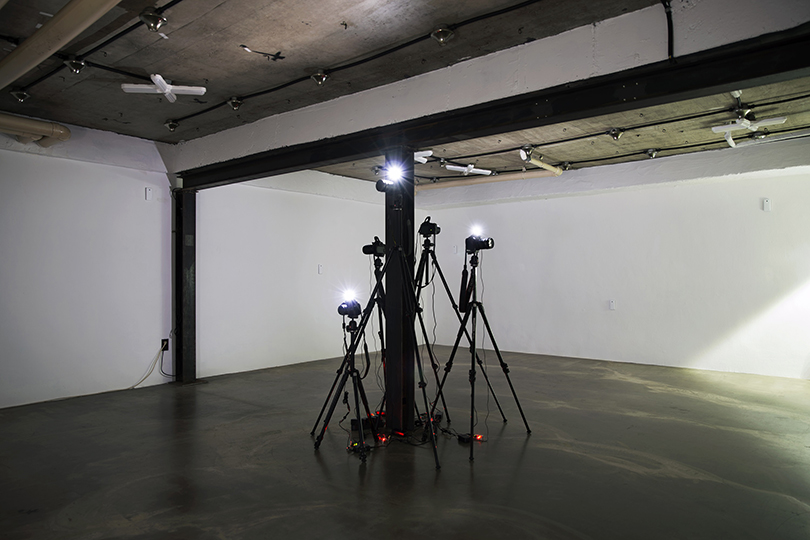
Present, DSLR Cameras, Tripods, Arduino Boards, 185 x 150 x 150 cm, 2017. Image courtesy of the artist.
As smart devices have become part of our everyday life, Jung’s work has also transformed to include audience participation. In Unsmart Phone Orchestra (2016), 10 smartphones are hung on the wall of the exhibition space with their screens facing the wall. Jung calls these smartphones, which cannot be controlled because their touchscreens are inaccessible, “unsmart phones.” On a music stand, a sheet of paper that resembles a musical score displays a series of printed phone numbers. Referring to the paper, spectators can play the unsmart phones’ different ringtones by calling the numbers. Jung’s Present (2017) consists of five DSLR cameras placed on tripods of different heights in the middle of the exhibition space. As the cameras’ shutters are triggered automatically, random flashes illuminate the empty walls and the spectators in the dark room. Viewers will be able to observe the shadows of themselves that appear in moments just as long as the duration of each flash. The new sounds that are created as the electronics are operated in ways different from their original purpose form one of the primary elements of the work, which shakes up moments in our daily lives.
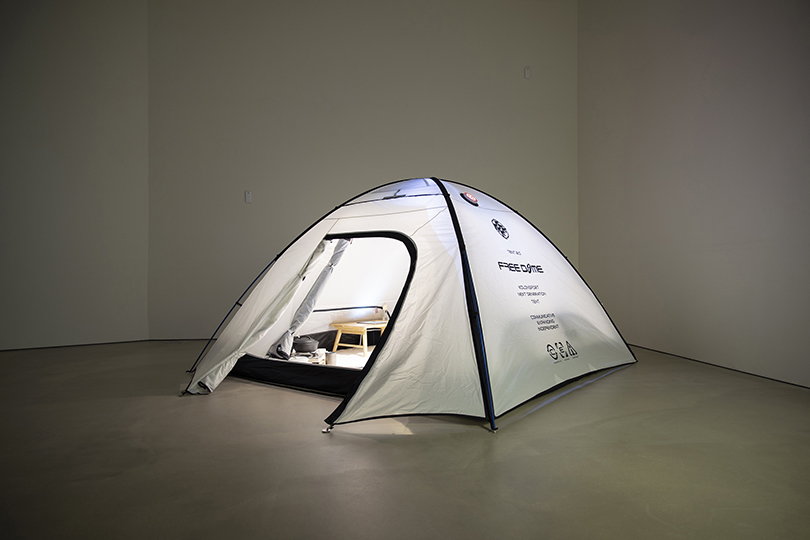
Home Void, Smart Tent, Smartphone, Tablet Computer, Laptop, Real and Artificial Succulents, Various Personal Items, 150 x 255 x 345 cm, 2018. Image courtesy of the artist.
In Home Void (2018), Jung once again encapsulates his interest in post-digital era lifestyles using smartphones and DSLR cameras. Installed in the exhibition space is a tent that audiences can enter to listen to the recorded sound of rain in the woods or take a whiff of an artificial forest scent. On a low table, a tablet computer displays an Instagram timeline where images uploaded by the user’s followed accounts scroll in real time. Visitors can also see that through a smartphone placed on a sleeping bag, the tent’s interior and the visitors themselves are being livestreamed online under the title “A Tent in the Forest.”
In Home Void (2018), audiences transfer from the position of a viewer to that of an object being viewed by anonymous internet users. Jung says that the work depicts a situation “(de)void” of the traditional sense of “home” due to people being forced to move frequently. Furthermore, as smart devices are commercialized and social media becomes a part of people’s daily routines, every single moment of everyday life is being turned into a commodity. Looking at technological development as the development of products, the artist continues his experiment of creating new relationships by purchasing and arranging ready-made electronic devices.
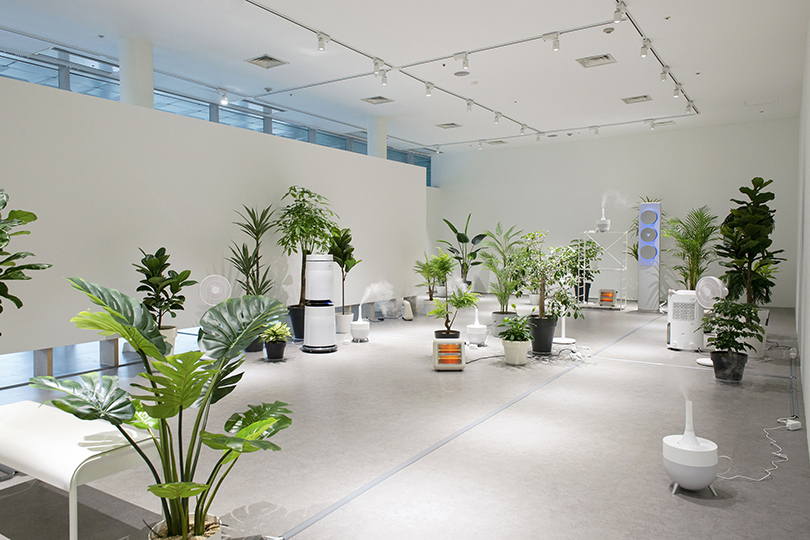
Strange Season, Air Conditioner, Air Purifier, Heaters, Fans, Humidifiers, Dehumidifier, Outdoor AC Unit, Real and Artificial Plants, Artificial Grass, Plant Pots, Shelf, Bench, Concrete Pedestal, Dimensions Variable, 2019. Image courtesy of the artist.
Jung’s installation work Strange Season (2019) is comprised of an air conditioner, air purifier, heater, fan, humidifier, dehumidifier, and real and artificial plants. When the heater increases the temperature in one area of the exhibition space, the air conditioner brings it down in another. When the humidifier turns on and increases the humidity, the dehumidifier starts to operate to combat it. While the fan circulates the air, the air purifier tries to keep it clean. The external air conditioning unit placed outside the exhibition space expels heated air from within it. The artist has said, “To me, volatile or extreme weather feels like a logical consequence rather than a strange one. What’s strange is the interior environment where a constant temperature, level of humidity, and clean air quality are maintained, isolated from outside conditions.”
In April 2019, the Korean government announced that Korea was the first country in the world to launch 5G wireless communication, declaring that the so-called “K-electronics” industry, represented by the electronics companies Samsung and LG, was excelling in the global market. The reason for the global success of “K-electronics” is the lifestyles led by the expanding middle class in places that are making rapid economic growth such as China, India, and Southeast Asia. Globalization points to the completely global distribution of products. Unique regional differences and individual lifestyles are vanishing, and the homogenous aesthetics of middle-class life is all that remains. The electronic devices that Jung uses as the materials for his work are products that any middle-class person across the globe has access to. His work portrays a world in which postcolonialism has come to a close and global capitalism has come to the forefront.
※ This content was first published in 『2021 MMCA Goyang Residency Program Catalogue』, and re-published here with the consent of MMCA Goyang.
YANG, Ji Yoon
YANG, Ji Yoon is currently the director of Alternative Space LOOP. She worked as a senior curator of Mimesis Art Museum and the director of Corner Art Space and participated in curator course at De Appel Arts Center in Amsterdam. She inquires into issues of visual culture extended from existing contemporary art and constantly pays attention to such works realizing radio, internet and social media into public communication.


